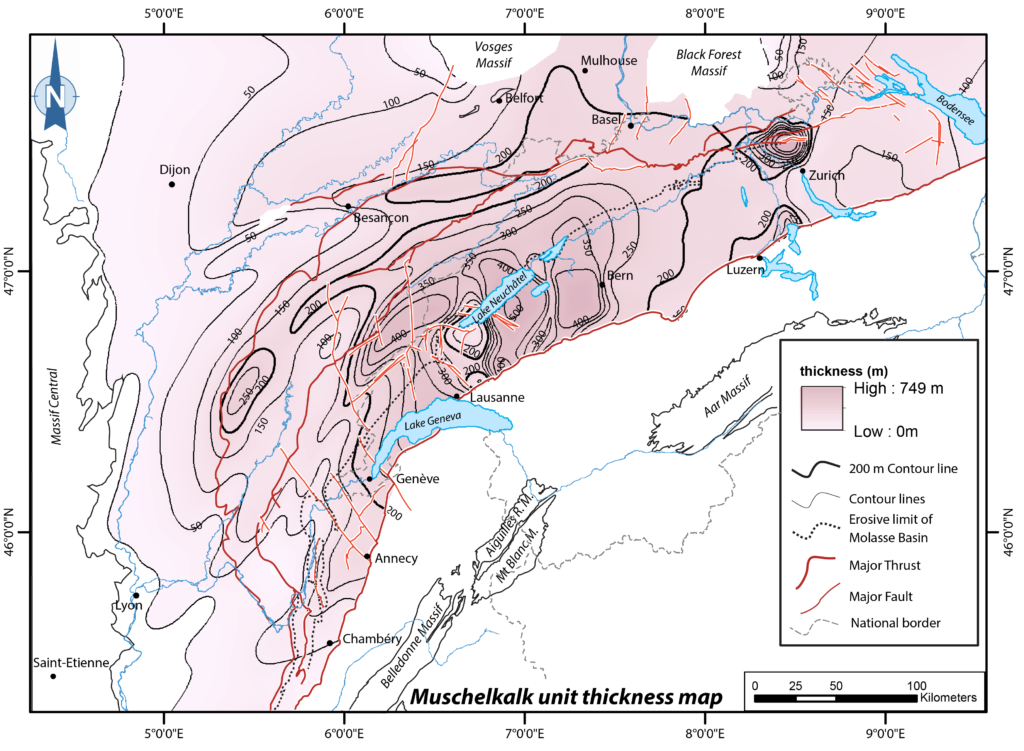We just recently finished a paper on a revision of the décollement level in the Alpine foreland: Sommaruga A., Mosar J., Schori M. & Gruber M. (2017): The role of the Triassic evaporites underneath the North Alpine foreland. Chapter no. 22, in section “Alpine Folded Belts” (part IV). In Juan I. Soto, Joan Flinch and Gabor Tari (Eds.), Permo-Triassic salt provinces of Europe, North Africa and the Atlantic Margins: tectonics and hydrocarbon potential. Published by Elsevier. http://dx.doi.org/10.1016/B978-0-12-809417-4.00021-5
The main maps have also been presented on a poster at the 2016 Swiss Geoscience Meeting in Geneva.

Fig. 7: Thickness contour map of the Muschelkalk unit in the Swiss Molasse Basin, the Jura FTB and the near vicinity . Cell size 500m, projection World Mercator, coordinates WGS84. Contour interval: 50m for thickness < 400m; 100m for thickness > 400m.
The main conclusion are :
The evaporites of the Middle and Upper Triassic play a key role in the development of the western Alpine foreland. They form the major décollement zone along which the Molasse Basin and Jura fold-and-thrust belt are deformed and displaced towards the foreland to the N-NW, above the mechanically rigid basement s.l.
Two main décollement horizons can be discriminated: the Muschelkalk unit and the overlying Keuper unit. The Muschelkalk layers act as main décollement zone in the East, and the Keuper layers in the West. The main thickness of the cumulated evaporite series is due to deformation and can be found under the central main range of the Jura fold-and-thrust belt. However, it can be shown that tectonic thickening of these series can also be correlated with individual structures, both in the Molasse Basin and the Jura Mountains. Based on our new distribution and thickness maps of the Triassic series, and especially the Muschelkalk and Keuper units, we suggest that the thickness in excess of >200 m in either of these units are due to tectonic processes. The original depositional thickness of these units appears to be rather constant and only minor thickness variations (<200 m) are due to the original paleogeography of the basin. One major exception can be seen in the Buntsandstein unit at the western edge of the Jura FTB, which is linked to a large half graben related to the Bresse Graben structure.
The main structural styles observed in relation with thrusting over the décollement zone range from fault-and ramp-related folds to evaporite-cored folds. This change in structural style is linked to sediment thickness above the décollement zone and the position within the critical wedge. Deformation directly associated with the décollement zone units of the Muschelkalk and Keuper are salt pillows and evaporite duplexes. Evaporites also core the major structures of the Central Haute Chaine of the Jura Mountains. They are the locus of important tectonic thickening of the evaporite formations. Multiple thrust levels can be observed and the weak evaporites facilitate stepping and forward propagation of the décollement over an inherited, possibly tectonic, basement topography. The Muschelkalk and Keuper units of the Middle and Upper Triassic act as a broad décollement zone with distributed deformation and multiple detachment levels.
Internal deformation of the evaporite layers in the décollement zone is highly heterogeneous and is strongly partitioned along several decollement layers. Deformation of anhydrite is controlled by temperature, strain rate, and grain size, as well as, the impurity content. The temperatures expected along the décollement zone increase from N to S from some 40° to 200°C. Thus the evaporites deform ductilly by intracrystalline deformation mechanisms, and locally mylonites may develop. With strain rates of 10-13-15 sec-1 and geothermal gradients up to 35°C the yield strength of salt is below 1MPa.
The foreland evolves from a flexural basin to a detached wedge-top basin with the activation of the décollement zone. The very weak décollement allows for a broad thrust belt and a narrow taper. The lateral variation in the décollement strength may explain the out-of-sequence thrusting as well as hinterland directed thrusting. The whole foreland behaves as a critical wedge that develops above the main décollement zone ramp in accordance with the Fernschub hypothesis and coeval with the imbrication of the External Crystalline Massifs in the Alps, with the Molasse Basin to the South and the Jura fold-and-thrust belt to the N-NW. Given the changes in topography and the décollement fault strength it appears that the foreland has not yet attained a state of equilibrium and is possibly still active, although under very low rates of deformation.